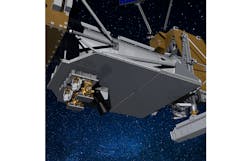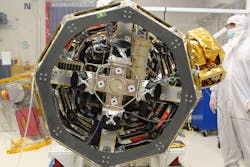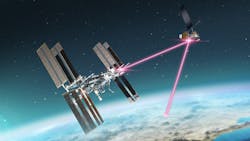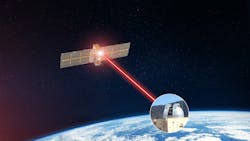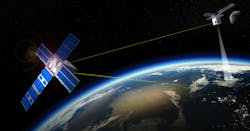The promise of laser communications to revolutionize optical links
Republished with permission from Military & Aerospace Electronics, a brand in Endeavor Business Media’s Design & Engineering Group alongside Laser Focus World.
Laser technology is emerging as a game-changer in satellite communications (SATCOM), enabling the creation of ultra-secure networks capable of transmitting vast amounts of data at unprecedented speeds via satellite networks and constellations. With ongoing advancements, the industry is poised for growth and collaboration, seizing the untapped potential of unconnected populations. The ability to handle the surging volume of data is a key advantage offered by laser communications, providing a significant value proposition.
While it has its challenges, laser communications is promising for defense and space applications as U.S. government agencies continue to embrace the forward prospects for laser communications as they invest in further developments to enhance its use.
A revolution in satellite communications
The global space-based laser communication market—mostly for commercial applications—was worth about $1.13 billion in 2022, and is expected to quadruple by 2031, growing at nearly 26% per year, according to research conducted by Straits Research in Maharashtra, India, titled Space-Based Laser Communications Market.
Space-based laser communications has emerged as a ground-breaking solution for data transfer in remote and challenging locations. This technology offers a wide array of applications like inter-satellite communications, and satellite-to-ground connectivity. As the number of orbiting satellites continues to grow, space-based laser communications is becoming a prominent player in satellite communications systems.
Investors, while cautious, are monitoring the industry’s progress closely to compete with major operators commercial like Starlink and OneWeb. The expansive customer base awaiting connectivity presents a lucrative opportunity for growth and collaboration. With laser communications offering faster speeds, improved security, and greater efficiency, it is poised to reshape the landscape of satellite communications.
Laser communications are poised to redefine secure and efficient data transmission not only in commercial markets, but in defense and government markets as well. Through technological advancements, increasing affordability, and a rapidly expanding customer base, laser technology is heralding a new era in satellite communications. As researchers continue to enhance laser diode efficiency, power output, and wavelength stability, the performance and reliability of laser communication systems are set to reach new heights.
In the international community, standardization efforts also are in progress, spearheaded by organizations such as the International Telecommunication Union (ITU) and other industry consortia. The establishment of common standards ensures interoperability and widespread adoption of laser communication systems. This enables seamless integration with existing RF infrastructure, creating hybrid systems that provide enhanced reliability and performance.
Despite atmospheric challenges affecting laser communications, innovative techniques such as adaptive optics, beam steering, and error correction algorithms are being explored to mitigate these effects. Overcoming these hurdles is crucial for the practical implementation of laser communications.
Suffice it to say that laser technology is revolutionizing the satellite communications industry. With its unparalleled capabilities, laser communications offer faster speeds, enhanced security, and increased efficiency than are available today. As the sector continues to mature, collaborations and partnerships will be instrumental in driving innovation and shaping the future of satellite communications.
Tim Dare is a distinguished engineer and a technical director at Booz Allen Hamilton, a technology research company in McLean, VA. Dare says the outlook for laser optical communications is bright.
Bright future
"Those advancing the technology are focused on exploiting the advantages of laser optical communications over RF communications such as increased bandwidth, small beam size, hard to intercept/detect or jam, and the ability to utilize a largely unregulated portion of the spectrum," Dare says. "These benefits provide an outlook for laser communications that has a market expected to grow from hundreds of millions of dollars to multiple billions of dollars by 2030 according to multiple market analysis studies.
The typical use of laser communications is for space. "Traditionally, laser communications have been developed and employed for space-based applications such as satellite to satellite and ground to satellite data transfer, this is due to the impacts of the atmosphere on laser communications for terrestrial, maritime, and air domains, to include bandwidth, pointing, acquisition, and tracking, and resiliency of communication through multiple atmospheric conditions," Dare continues.
"Technology developers are now concentrating investments on increasing the practical use of laser communications within these domains such as bandwidth, distance, and resiliency through a variety of atmospheric conditions," Dare says. Bandwidth nominally is in the 1 to 10 gigabits per second range today going to hundreds of gigabits per second in the future. Distance today is about 1 kilometer to up to tens of kilometers going to more than 50 kilometers in the future for terrestrial-terrestrial applications.
Kevin Huttenhoff is a senior manager for space data transport at the Lockheed Martin Space Systems segment in Denver. He also emphasizes that laser communications have many advantages: precise and targeted beams, difficulty to jam, and notable bandwidth. He, too, is bullish on the outlook for laser communications.
"The future of laser communications for satellite communications is very bright," Huttenhoff says. "Secure intersatellite links as well as space to ground communications will both leverage this technology in the future. While there will still be a need for spectrum management as this capability proliferates, this management should be much easier due to the narrowness of the beams."
Booz Allen's Dare says he sees the future of laser communications to rest much on reliable technologies that can operate through a wide array of atmospheric conditions.
"Implementing reliable technologies to increase bandwidth and operate in a variety of atmospheric conditions will eventually explode the terrestrial, maritime, and air domain laser communications markets within the next 3-5 years," he says.
"The importance of creating solutions in these domains allows the use of laser communications to be leveraged in situations where radio frequency (RF) is contested, not available, or not affordable, such as in contested or anti-access/area denial (A2AD) environments, austere environments, on-the-move capabilities, and having to lay fiber in difficult terrain or urban areas, Dare continues.
"Each of these capabilities can be utilized in multiple markets, such as defense, civil, commercial, and agricultural. We anticipate the markets will expand its laser communication usage in the next few years to leverage the benefits mentioned as the capabilities and practicality of laser communications through the atmosphere become widely available," Dare says.
Not without challenges
Laser communications are influenced by the atmosphere they penetrate and transmit through; if not ideal, communications may have problems. Namely, the beam that is used for directional communications can be fidgety against different atmospheric conditions. According to Booz Allen’s Dare, these and other considerations mean that laser communication has its challenges.
"One of the advantages of laser communications, the small beam size, also presents one of the most difficult challenges in implementation," explains Dare. "The small beam requires very precise control to establish and maintain the link. This is referred to as pointing, acquisition and tracking (PAT)."
Pointing the laser in less-than-ideal conditions can be a challenge.
"The line-of-sight nature of laser communications necessitates an understanding of where to transmit (point), allow for link establishment (acquisition), and an ability to adjust to maintain the link (tracking)," Dare says. This PAT equation becomes more challenging when transmitting through a domain that can impact the beam-the atmosphere or water (for subsurface communications).
Converting satellite laser communications links for in-atmosphere links can be an option. "PAT systems are in use today for some laser communications such as satellite to satellite and terrestrial to satellite," Dare says. "These systems can be upgraded to provide the capabilities for the more complex systems that are purely within the atmospheric domain to allow for laser communications on the move (terrestrial, maritime, air, or subsurface) through a PAT system."
Establishing a laser communications link is one thing, but maintaining it can be quite another. "A challenge that must be overcome includes the ability to establish and maintain an on-the-move link in potentially challenging 3-axis conditions, countering the effects of sea state, rugged terrain, air turbulence, or subsurface currents. Another basic challenge that must be overcome is the condition of the atmosphere (or subsurface)," Dare says. "Several conditions can cause interference with a high-quality laser communications link such as dust, heat, turbulence, rain, spray, clouds, etc. Any solution that will be resilient enough to work in a true operational environment must have the ability to counter the impacts of these conditions to maintain a reliable link."
Lockheed Martin’s Huttenhoff says he also sees challenges. "Several challenges are present as we continue to mature this technology for the future," he says. "First, if systems are going to be interoperable with each other, then some form of standard will need to be generated by industry to be an enabler. Second, as we look at the increasing data-rates that are possible with laser communications, the need for processors that can perform data switching and processing in space at these rates will need to be developed."
Booz Allen’s Dare says that until these challenges are overcome, space and defense leaders should utilize laser communications as an additional tool to address their communication requirements. "It is a complement to RF communications as part of an overall plan. Additionally, it is important to note that laser communication is not a one size fits all solution; laser communications can provide a highly tailorable solution based on mission and domain requirements," he says.
Many use cases for laser communications
As Dare explains, laser communications crosslinks have been employed in the space environment for applications like satellite-to-satellite links, ground to satellite links, and "last mile" connections terrestrially, which can bypass the need for fiber optics.
"These applications will continue to expand to increase distance, setup time, and dynamic situations to allow reliable on-the-move communications," he says. "The current state of laser communications for terrestrial applications are limited in throughput and distance due to the precision required for establishing and maintaining a link as well as varying atmospheric conditions. At this point laser communications is applicable to a niche market due to the limitations, however systems can be provided to meet specific customer needs that utilize stable platforms—these systems can be miles apart and provide gigabits per second speeds; however, they will still be impacted by atmospheric conditions.”
As technology advances, laser communications increasingly will shift to cross-domain opportunities—particularly in terrestrial and ground to space applications. For RF communications this will provide an ability to expand data flows that the spectrum cannot accommodate."
Dare adds that there are advantages and scenarios where laser communications are best used. "We see government customers exploiting the low probability of interference and low-probability-of-detection attributes and employing laser communications in covert scenarios or in an RF denied environment," says Dare. "Specific areas of growth for terrestrial applications will depend on the ability to acquire and maintain link, and more importantly to increase bandwidth with high resiliency to be able to communicate in a variety of atmospheric conditions. It is clear the benefits laser communications bring to contested and denied RF environments, however the ability of significantly increasing reliance in multiple atmospheric conditions and also reducing the Size, Weight, Power and Cost (SWaP-C) will be key to providing end users a capability that will meet needs across all markets."
Investments in laser communications
There are many initiatives across government agencies. The U.S. National Aeronautics and space Administration (NASA) in Washington, for example, seeks to advance laser communications. Several other research initiatives are in progress that stand to serve defense needs. They are taking steps to enhance the capabilities of laser communications and are collaborating with industry leaders to get down to the nitty gritty of optical materials that could be useful and disruptive for laser communications in important defense applications.
The U.S. Defense Advanced Research Projects Agency (DARPA) in Arlington, VA, issued a disruption opportunity in May for Accelerating discovery of Tunable Optical Materials (ATOM) project seeking breakthroughs in tunable optics for free-space optics and integrated photonics intended for use in laser communications. See more about the project online at www.militaryaerospace.com/14294160.
Phase change materials, which can switch between amorphous and crystalline states through thermal energy, are particularly appealing for these purposes. Germanium antimony tellurium, a commonly considered phase change material, exhibits fast switching times of less than 10 microseconds and substantial index contrast. However, its usefulness is restricted by considerable loss in short-wavelength applications below the short-wave infrared range.
The ATOM program’s aim is to discover new tunable optical materials that possess large refractive index contrast across the entire spectrum while maintaining low loss and fast switching times. The program also seeks to demonstrate a device with a minimum area of 250 square microns, capable of achieving repeatable and stable multi-state switching, all while preserving bandwidth and performance.
Late last year, DARPA also moved forward with industry-contracted research to develop miniature optical beam steering for applications like free-space laser optical communications and light detection and ranging (LiDAR) for use in laser communications. Late last year they launched a microsystems exploration topic on Tuesday (DARPA-PA-21-05-01) for the Steerable Optical Aperture Receivers (SOAR) project; read more at www.militaryaerospace.com/14282827. SOAR will explore new approaches to optical beam steering in miniature form factors, and experimentally demonstrate their operation in receive mode with small aperture sizes.
Currently, optical beam steering primarily relies on mechanical systems such as gimbals or motors to adjust the direction of optical lenses. However, these gimbal-based beam steering systems are often too large and heavy for small autonomous vehicles that require onboard laser communications and LiDAR capabilities.
Integrated photonics has emerged as a plausible solution to assist microscopic devices on chips replicate the functions of discrete optics. According to the announcement, this not only leads to a significant reduction in size but opens possibilities for new and intricate optical system architectures that were previously impractical at the macroscopic scale. The impetus behind the SOAR project is to address critical questions regarding optical receiver performance, scalability, and integration.
Intricate optical systems
SOAR aims to develop optical interfaces capable of receiving light from any direction without precise knowledge of the incoming angle. This is achieved by steering the angle of acceptance to capture and couple the input beam into a common output mode or detect the optical signal within the receiver interface.
SOAR is technology-agnostic; It aligns with the program’s goals. Two-dimensional optical parametric amplification (OPA), non-planar integrated photonics, optical metasurfaces, directional optical scattering techniques, and discrete micro-optics are all among the approaches that researchers are considering, in addition to the generation of multiple simultaneous beams is of interest to the project.
The U.S. Space Development Agency (SDA) is investing in low-Earth orbit satellite development
In parallel to DARPA, the U.S. the Space Development Agency (SDA) is also aggressively investing in and collaborating with industry to pursue advanced research to assist laser communications. The agency announced in March of 2022, that Northrop Grumman Corporation was selected to create an innovative constellation of 42 low-Earth orbit (pLEO) satellites and establish the Tranche 1 Transport Layer (T1TL) mesh satellite communications network. The Space Development Agency, a new agency, plans to boost the delivery of space-based capabilities to support terrestrial missions.
The announcement described the T1TL network as a low-latency, high-volume data transport network used to support critical U.S. military missions. Its primary objective is to connect various components of an integrated sensing architecture, ensuring persistent and secure connectivity. The network is expected to play a vital role in the Joint All Domain Command Control initiative.
Specifically, the T1TL network will integrate advanced technologies and infrastructure to enable future space missions, prioritizing key aspects such as battle management, missile tracking, and target custody. According to the announcement of the initiative, laser communication terminals will be employed to connect the global constellation, while providing persistent, networked Link-16 and high-rate Ka-band connectivity to air, maritime, and ground users
Northrop Grumman is collaborating with commercial marketplace partners. Their intent is to assist SDA’s efforts to boost speed and expedite the delivery of an innovative system.
Northrop Grumman has a good history in this type of work and is credited with the assembly, integration, and testing of the sophisticated Iridium NEXT satellite constellation, consisting of 81 satellites that were successfully launched into low-Earth orbit in 2019.
The road ahead for laser communications
The research sponsored by DARPA and SDA is among the many efforts to improve secure high data-rate laser communications via satellite. Kevin Huttenhoff of Lockheed Martin says that the future of secure, high data-rate satellite communications along with the benefits of optical communications are becoming very compelling. "We can envision a data-centric satellite communications architecture in space that is enabled utilizing laser communications," he says. "This would include not only satellites in low earth orbit, but higher data-rate terminals in medium earth orbit providing data backhaul. By leveraging such an architecture, we can envision data reaching the user with much less latency than today."
Tim Dare of Booze Allen says that while there may be challenges ahead in the forward progress of laser communications, there’s much reason to be optimistic.
"As with any new technology, there will be multiple industry and government initiatives that will try to get to market first to exploit the benefits of laser communications," he says. "The problem set in implementing a reasonable cost, reliable, high-bandwidth solution is not small, and care must be taken when thinking through the myriad of potential solutions. Developers of the technology must focus on the end user and the environment in which they will be using laser communications. It will be a non-stable, dirty environment with most likely poor atmospheric conditions. The internal mechanisms for laser communications demand a clean environment with precision in the transmit and receive modules for optical alignment. The mounts must be rugged enough to withstand the environment and handling of the system without damaging or causing internal alignment or contamination issues—these are not easy problems to solve."
Dare emphasizes that early adopters of the technology exist and understand that there will be success and failures in being able to use the new technology. "It is important that solution providers and the early adopters work together closely to allow the technology issues to be resolved," he says. "The benefits for laser communications are great and one day will become a standard part of the communications toolkit; as such, the ability to find partners to allow the technology solutions to be refined in a true operational environment will be key to achieving those positive outcomes."
About the Author
John Keller
Editor-in-Chief, Military & Aerospace Electronics
John Keller is the Editor-in-Chief of Military & Aerospace Electronics, a brand in Endeavor Business Media’s Design & Engineering Group alongside Laser Focus World. The brand provides extensive coverage and analysis of enabling electronics and optoelectronic technologies in military, space, and commercial aviation applications.
John has been a member of the Military & Aerospace Electronics staff since 1989 and chief editor since 1995.
